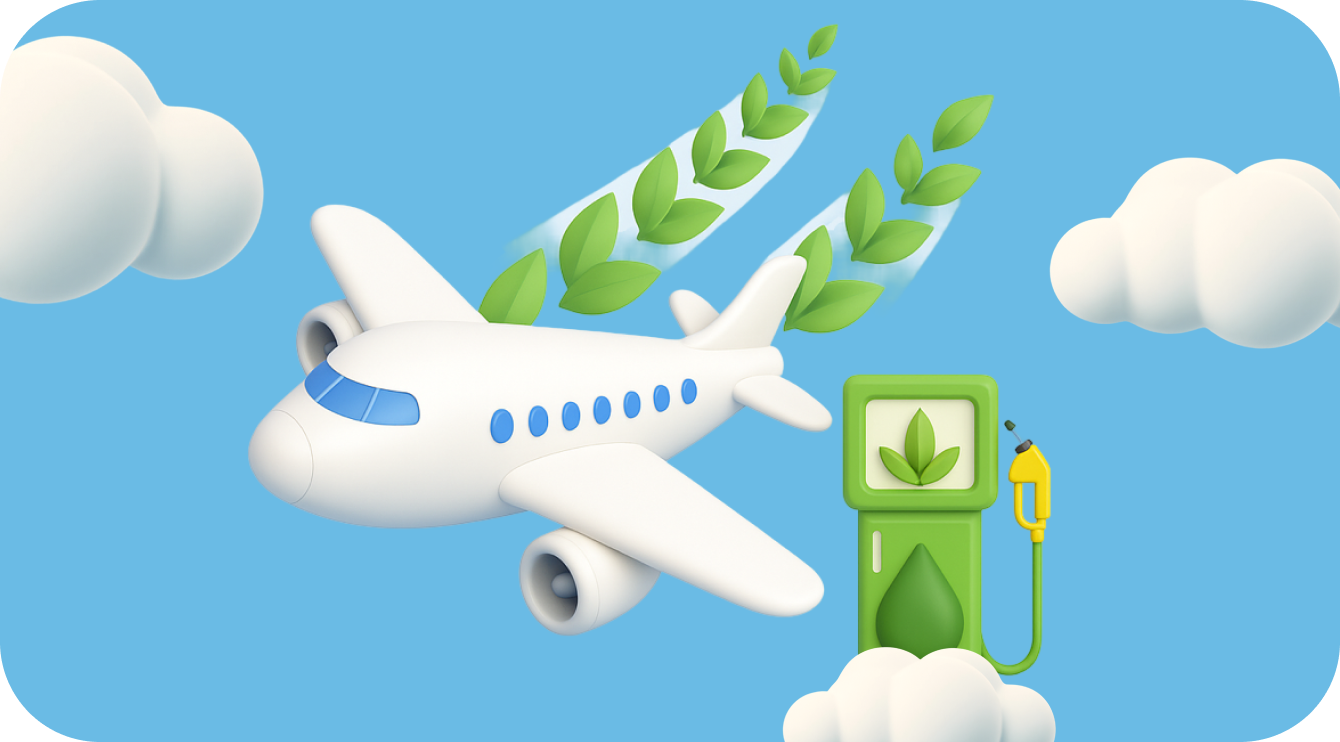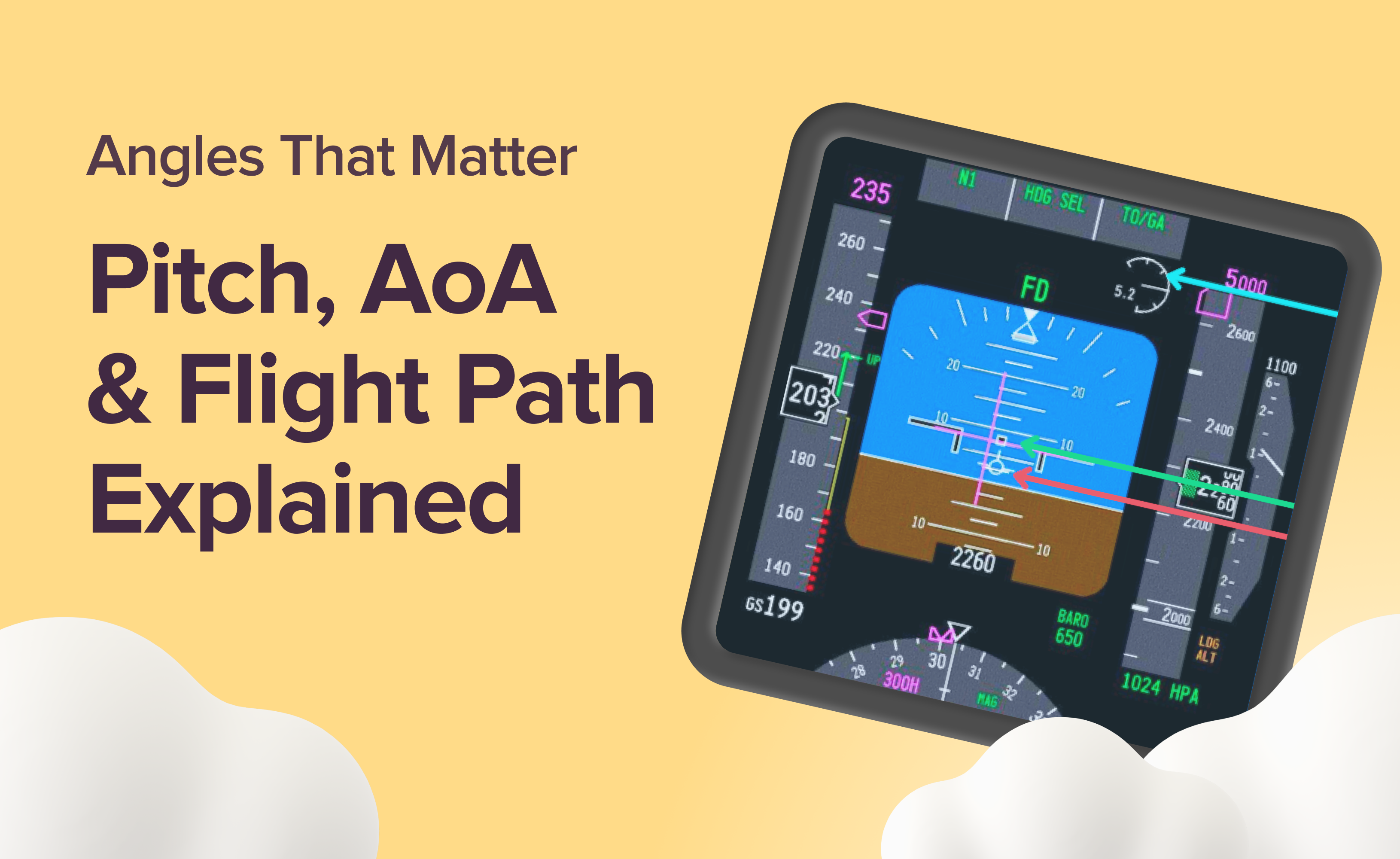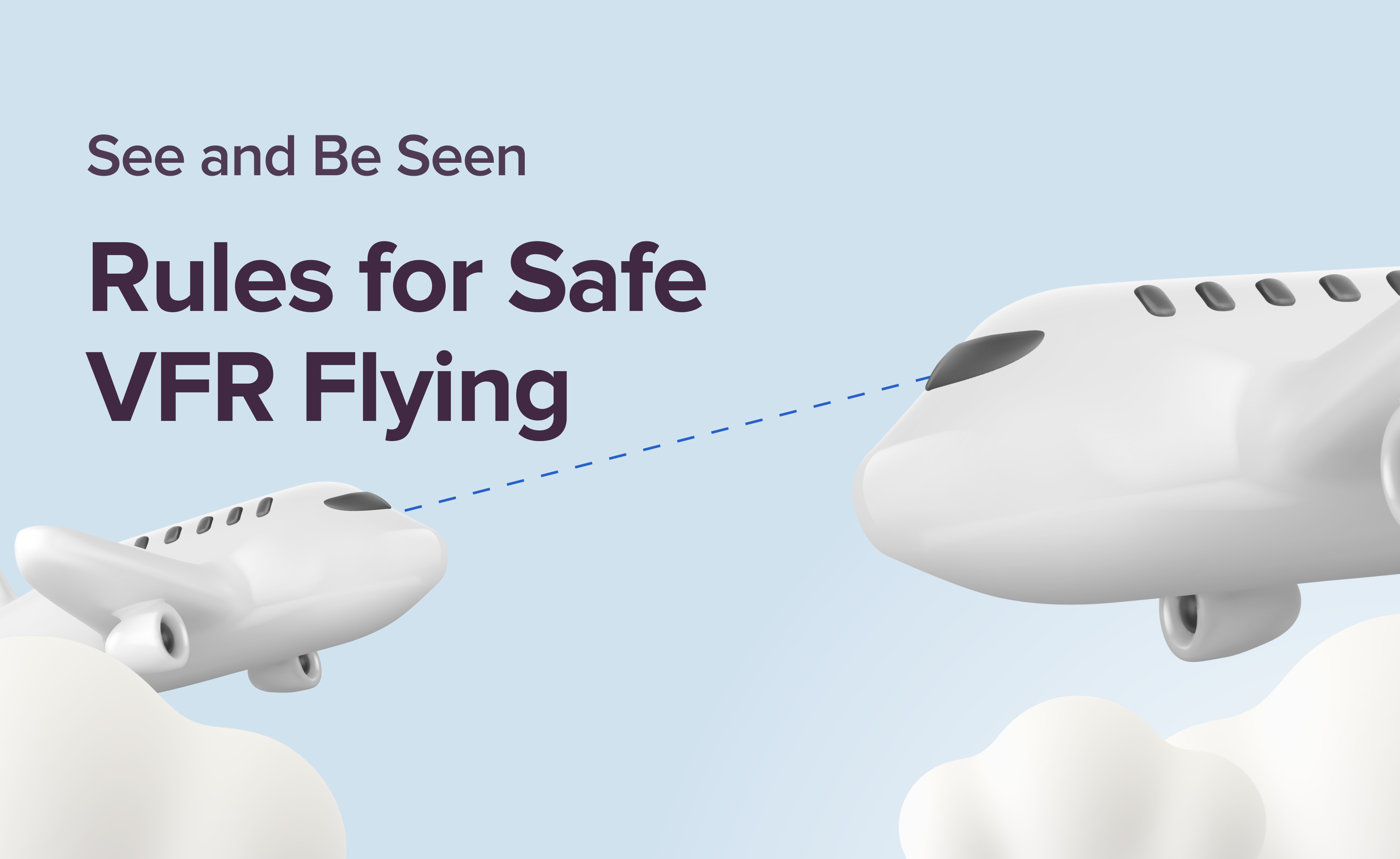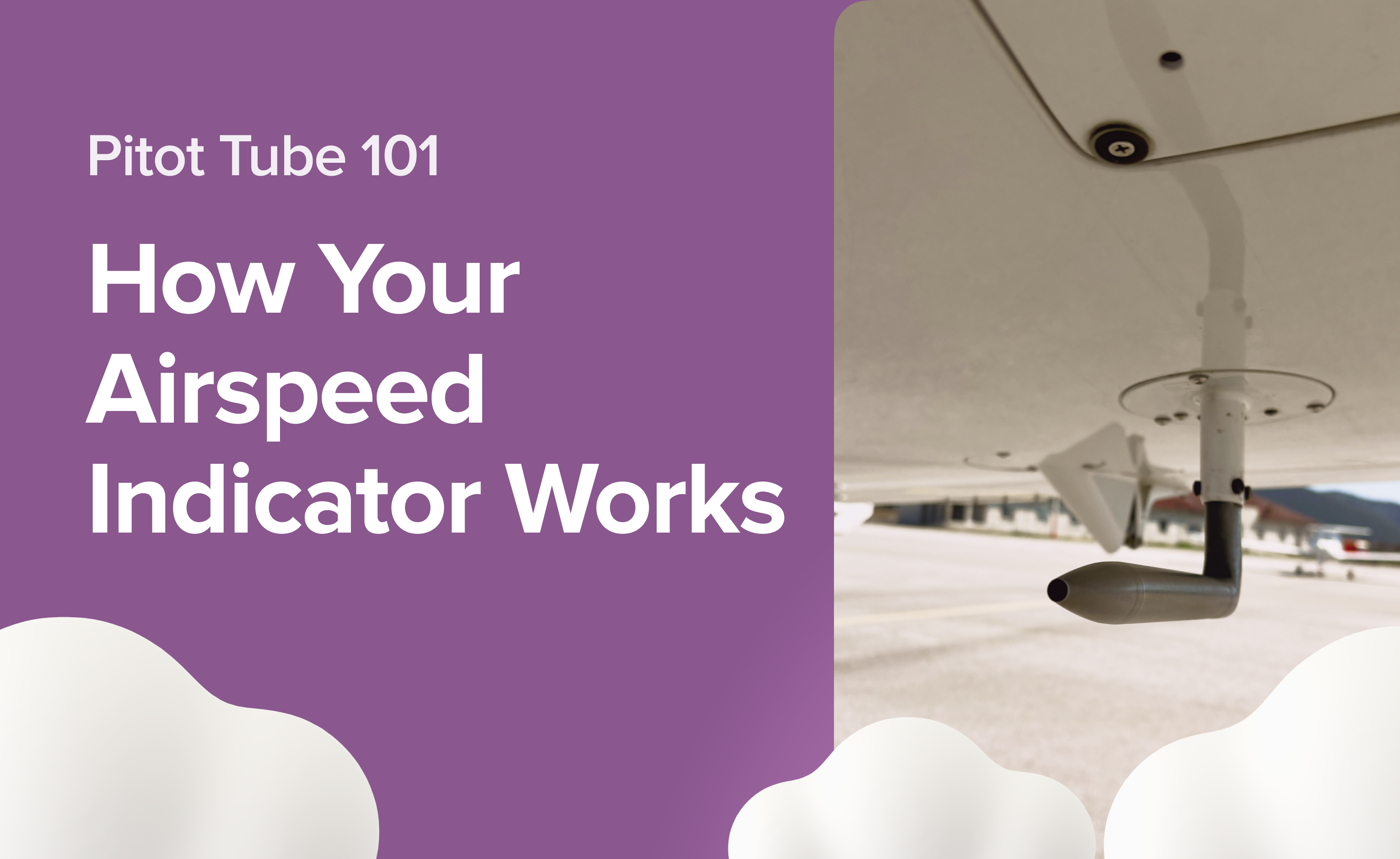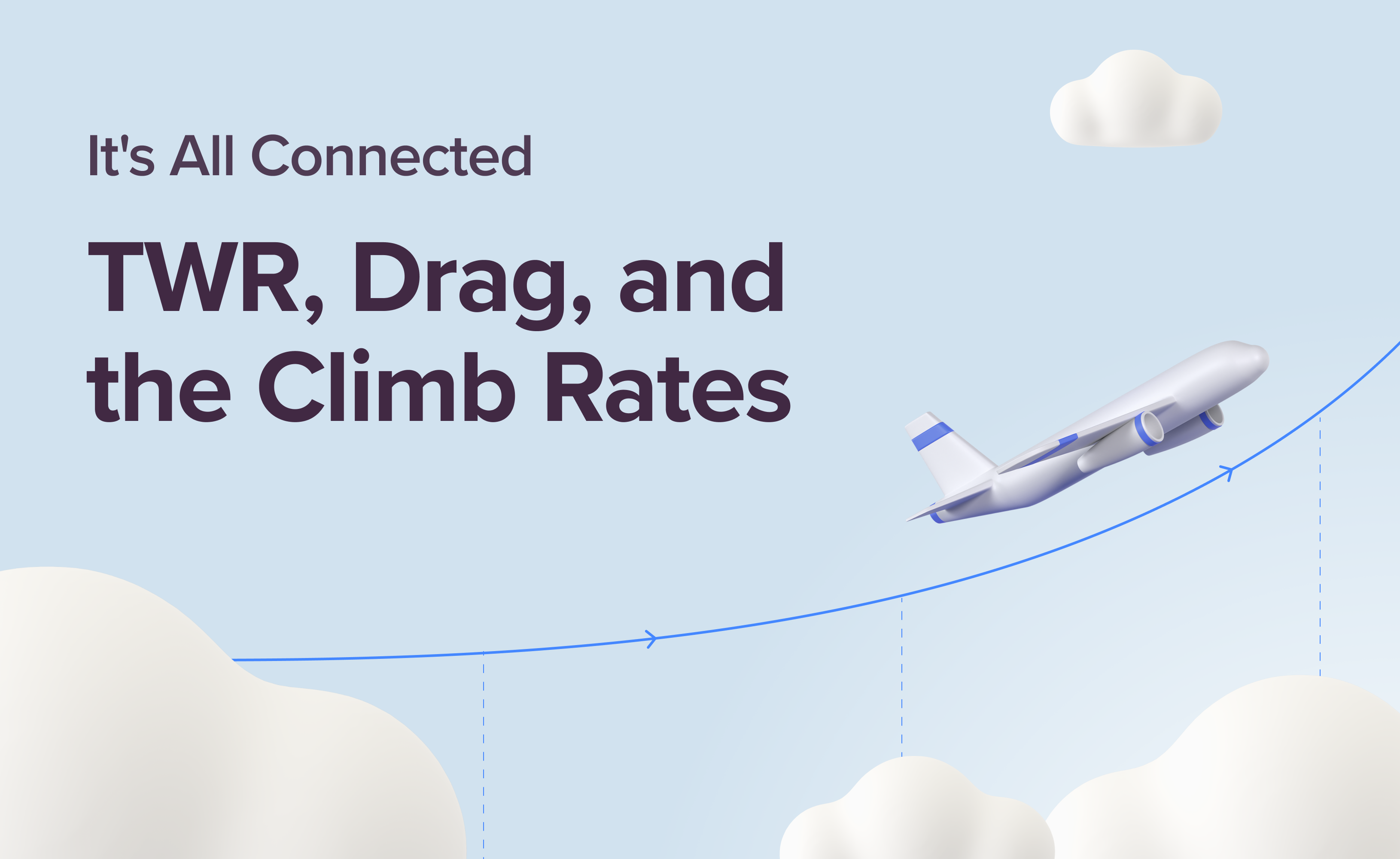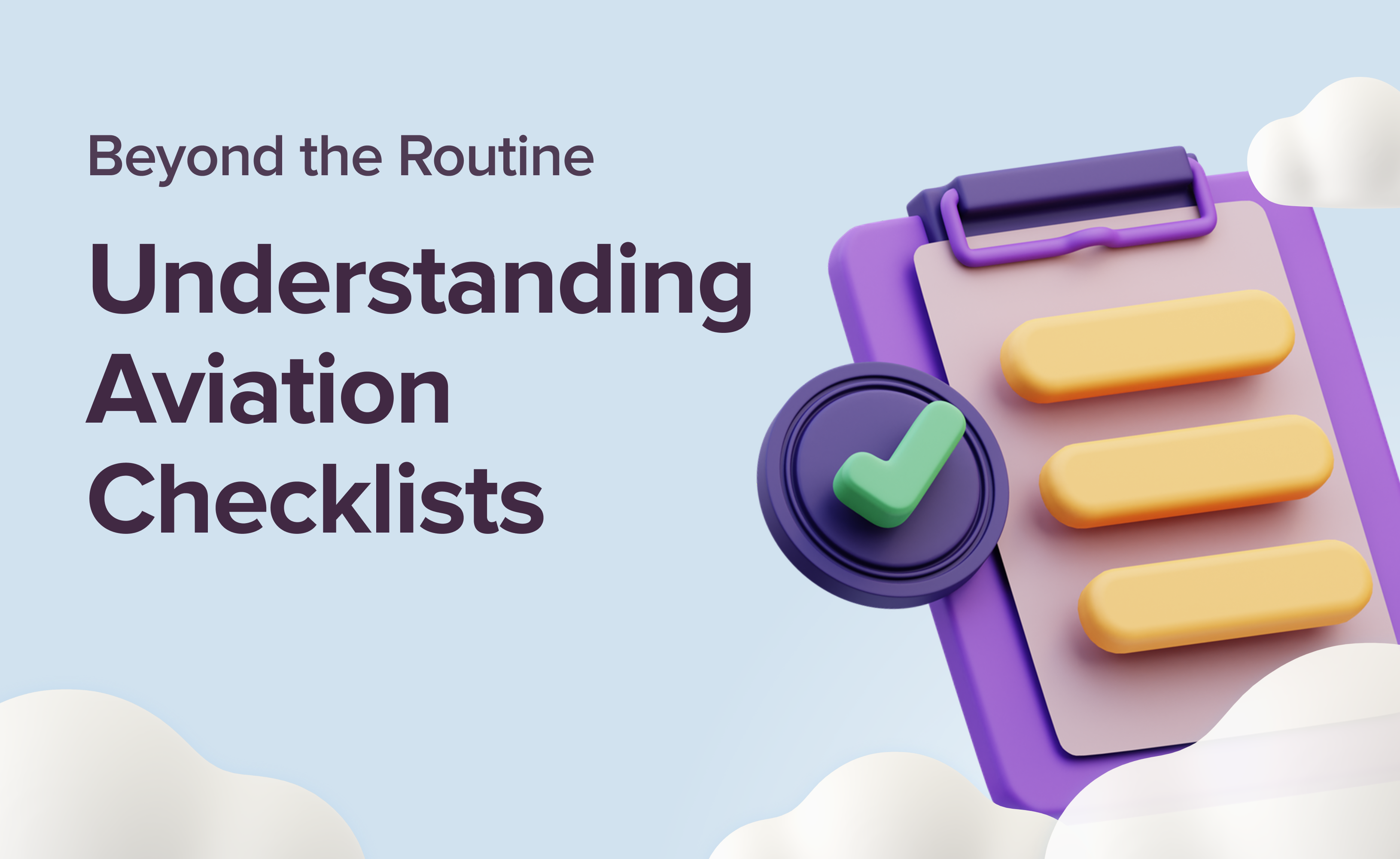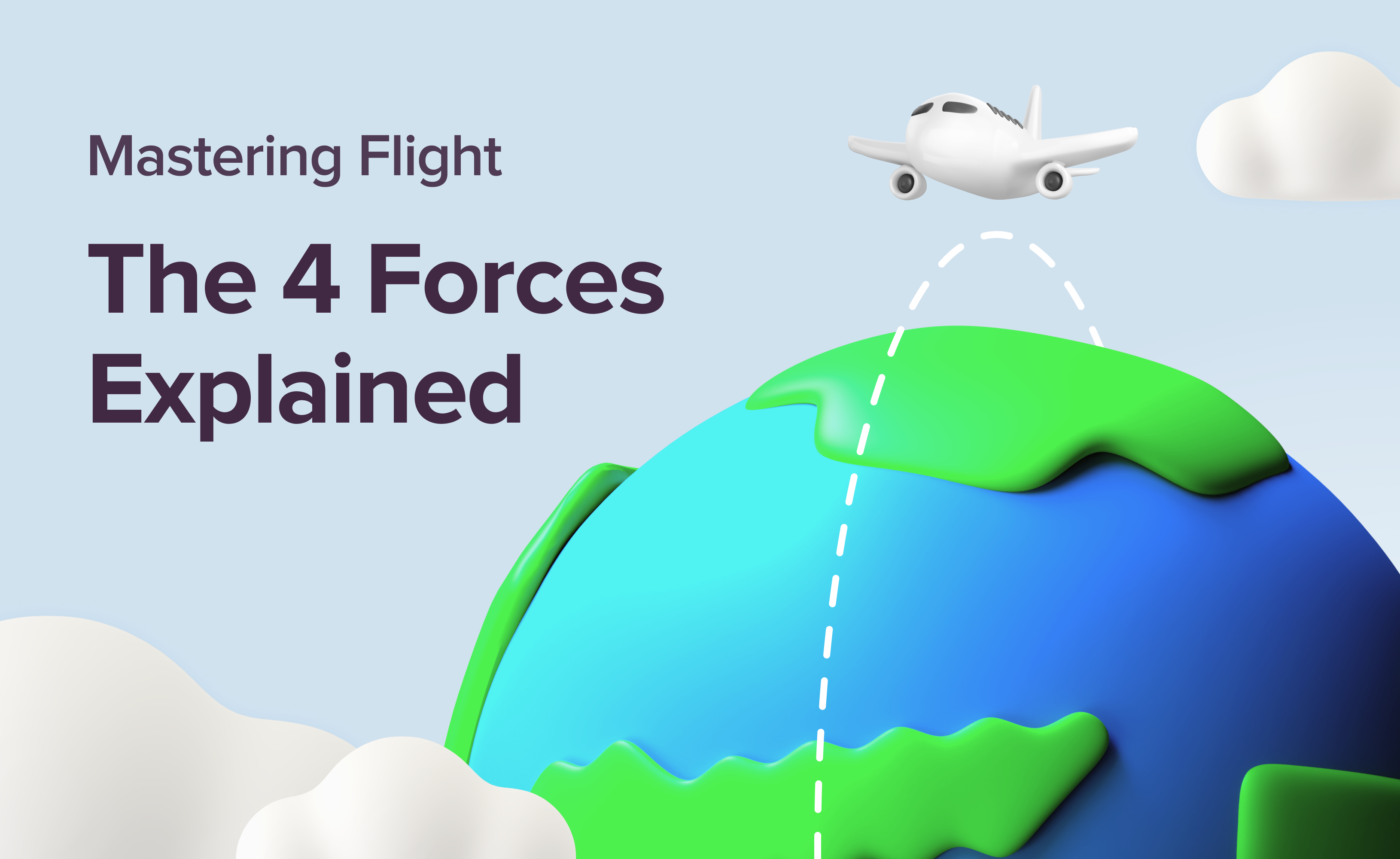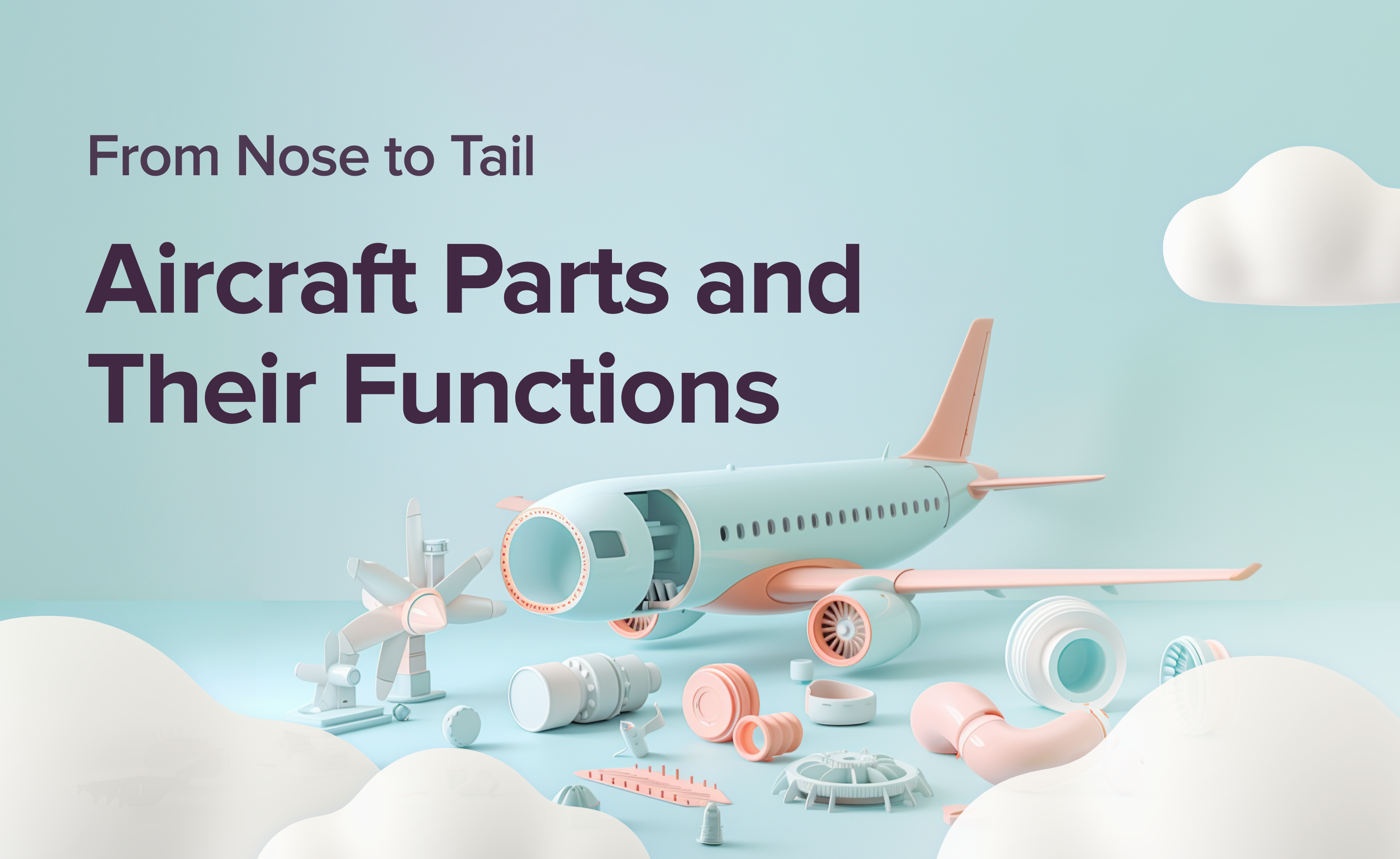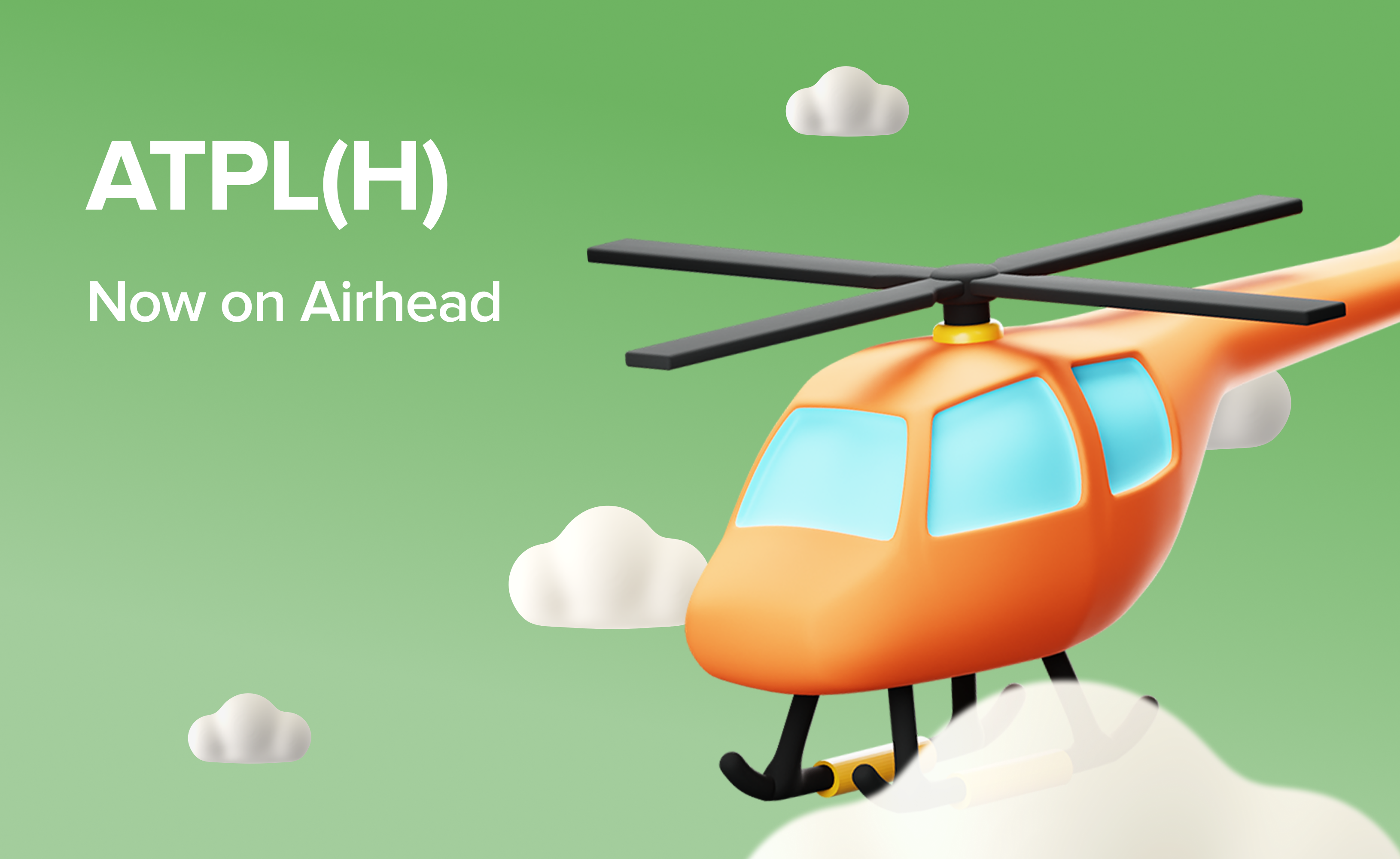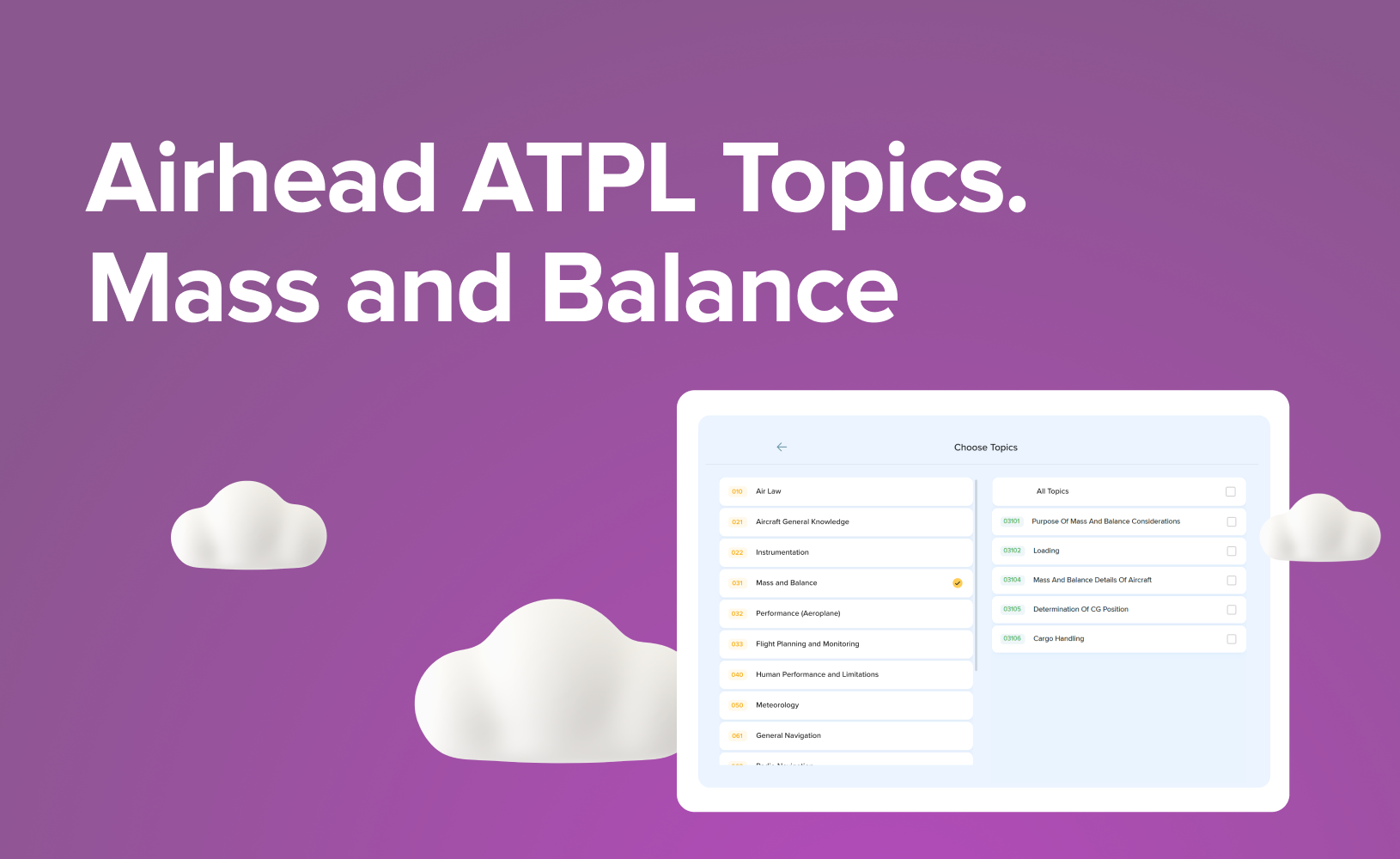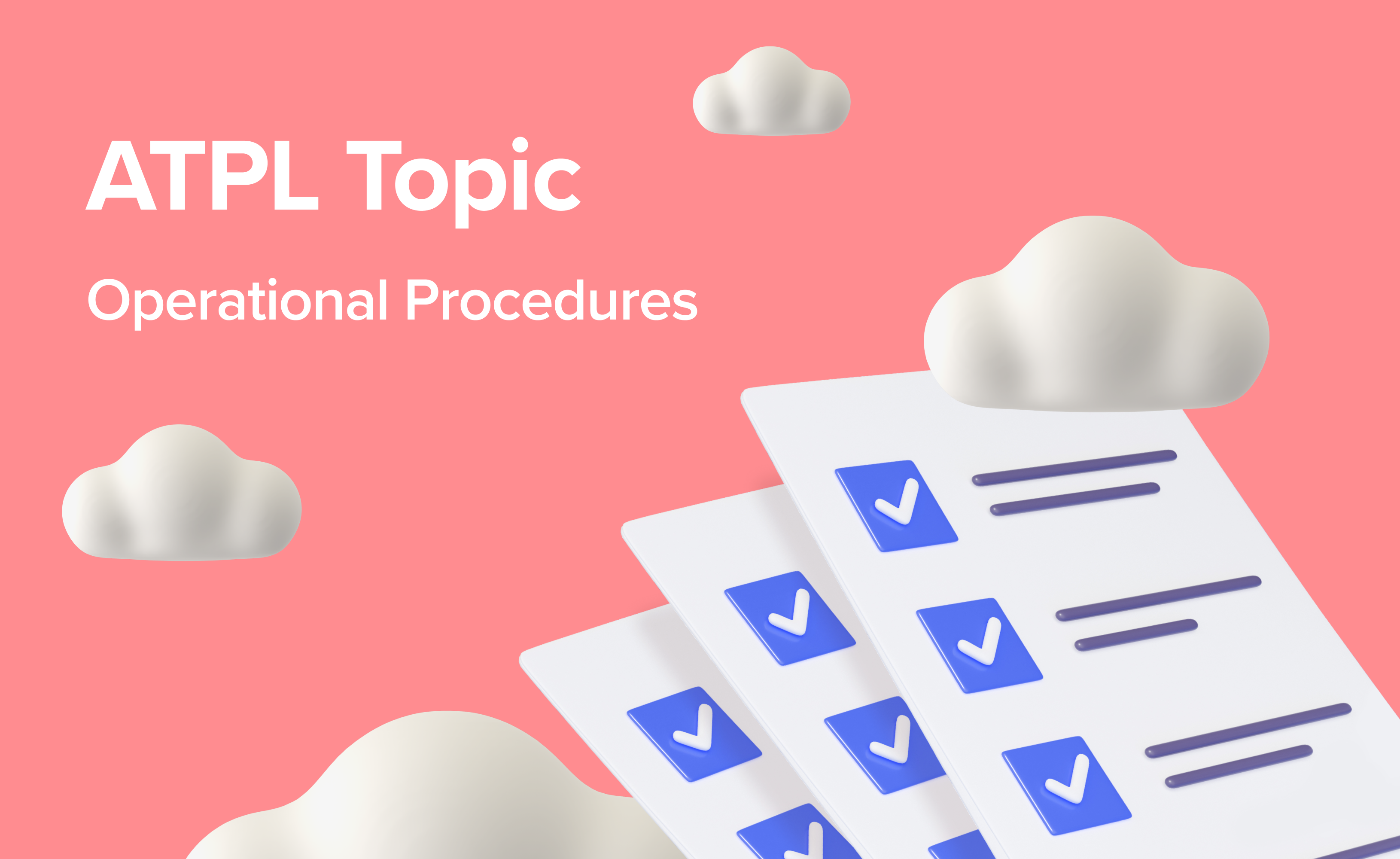Fuel Up! A Practical Guide to Aviation Fuel
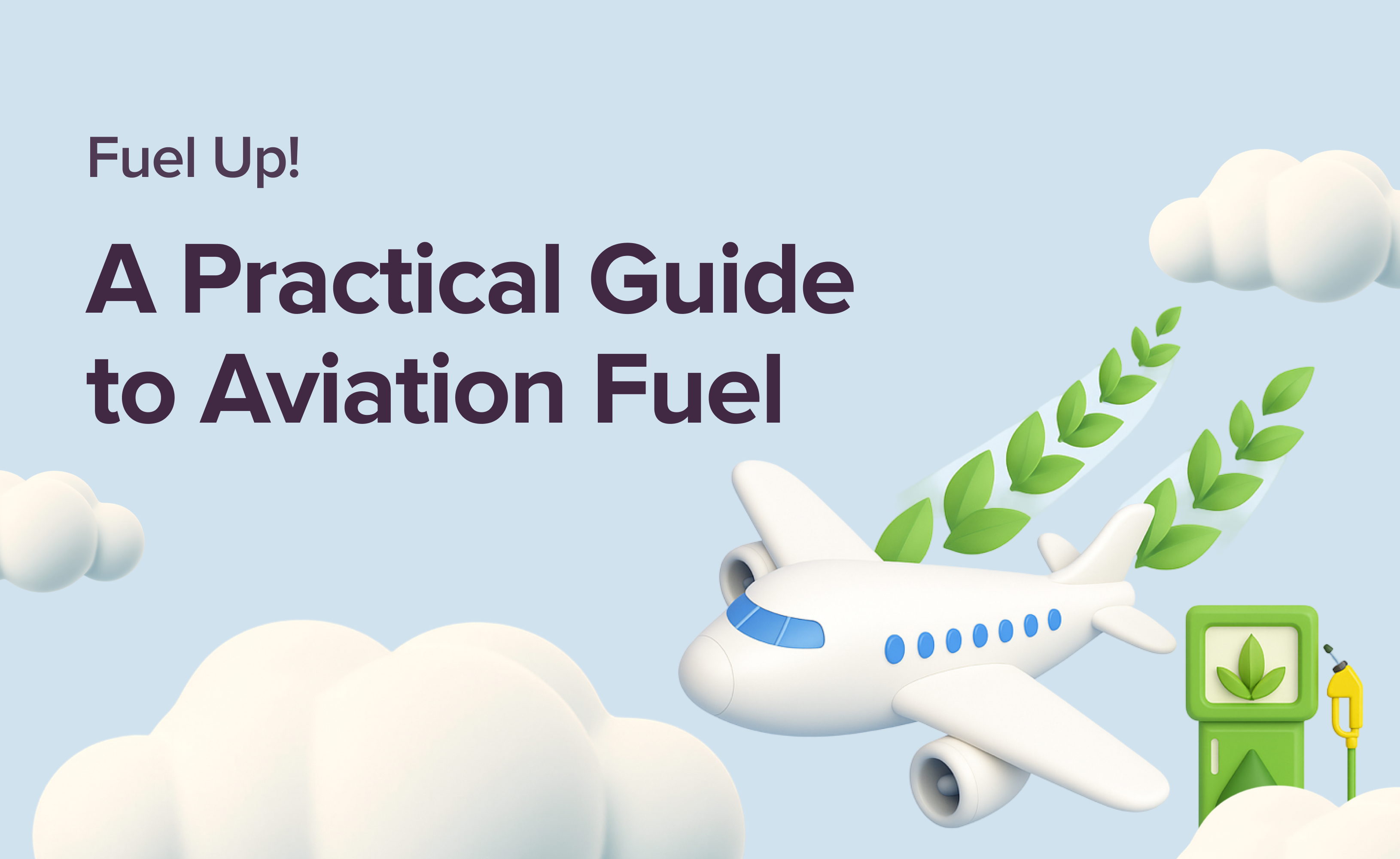
Fuel is one of the most critical and complex factors in flight operations. From choosing the right type to calculating how much you’ll need (and where you might need to dump it in an emergency), pilots make a number of fuel-related decisions before the wheels even leave the ground.
In this post, we’ll break down the different types of aviation fuels, walk you through the basics of fuel planning, and explain what really happens when aircraft need to dump fuel. Whether you're in training or just aviation-curious, this guide will give you a solid understanding of the fuel that keeps the skies moving.
Wondering if a pilot career in aviation is right for you? Discover 10 signs that reveal whether you’re destined to become a pilot.
Types of Aviation Fuel
What's powering the planes in the sky? The answer isn't a single type of fuel. From jet engines to piston engines, the choice of fuel depends on everything from design to altitude. Let's explore the most common types of aviation fuel and the aircraft they power.
Jet A & Jet A-1 (AFTUR)
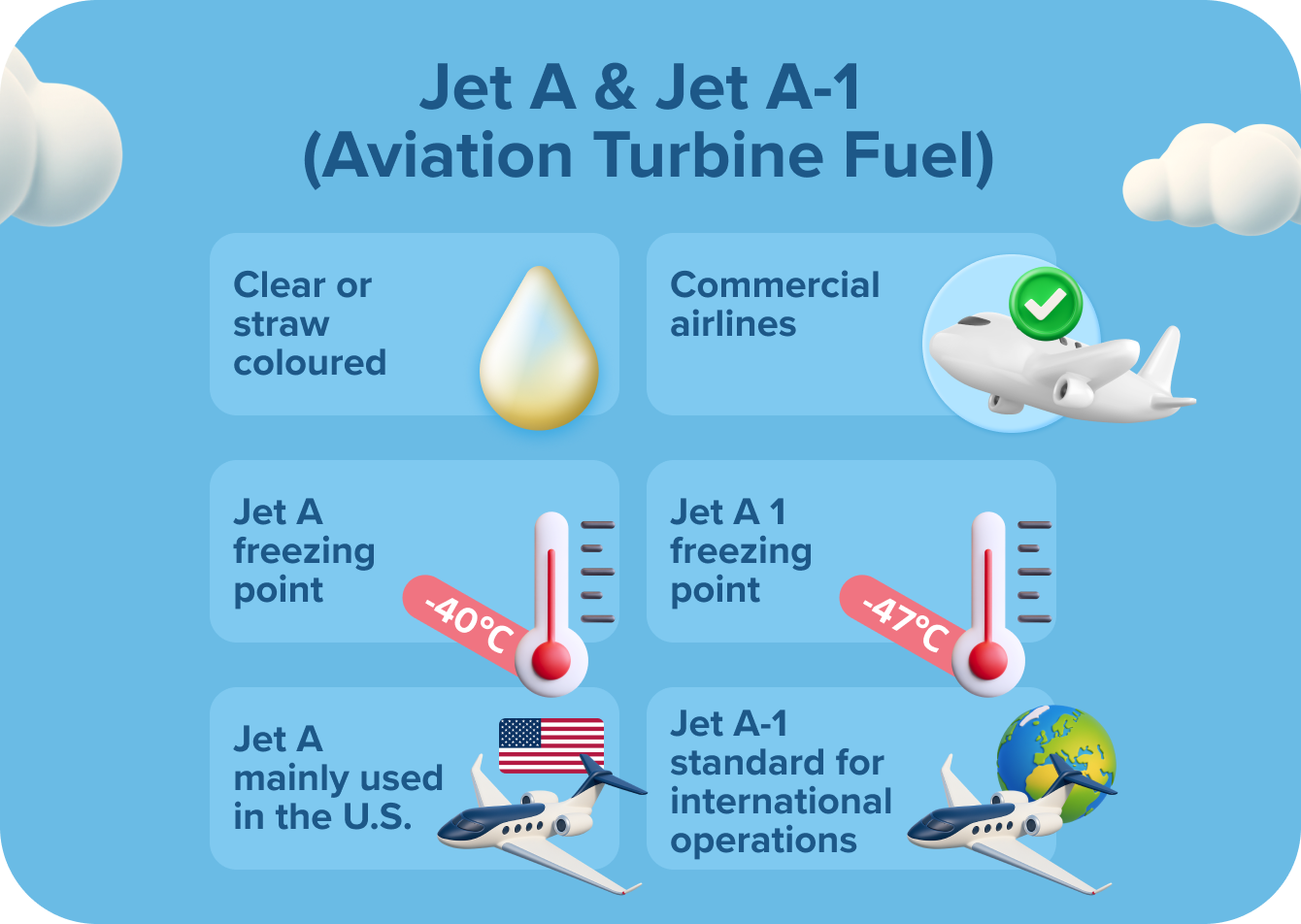
Used by: Commercial airliners, business jets, most turbine aircraft
Also known as: AFTUR (aviation turbine fuel)
Jet A and Jet A-1 are the workhorses of the aviation world. They are kerosene-based fuels used in turbine engines. The main difference? Jet A-1 has a lower freezing point (−47°C), making it ideal for long-haul, high-altitude flights, especially in colder regions.
Jet A: Mainly used in the U.S.
Jet A-1: Standard fuel for international operations
Think of Jet A-1 as the “global passport” of jet fuels — versatile and freeze-resistant.
Turbofan or turbojet? What's the difference, and which is better? Find out in this comparison of these two powerful jet engines.
Avgas (Aviation Gasoline)

Used by: Piston-engine aircraft (e.g., Cessna 172, Piper PA-28)
Types: 100LL (Low Lead) – dyed blue; Avgas 100 – dyed green
Avgas is the aviation version of gasoline. It’s used in smaller aircraft with spark-ignition engines. The most common variety today is 100LL, which, despite the “low lead” name, still contains tetraethyl lead (for octane boosting).
There's a global push to develop unleaded Avgas alternatives that still meet performance demands. So lead is on the way out in the near future.
MOGAS (Motor Gasoline)
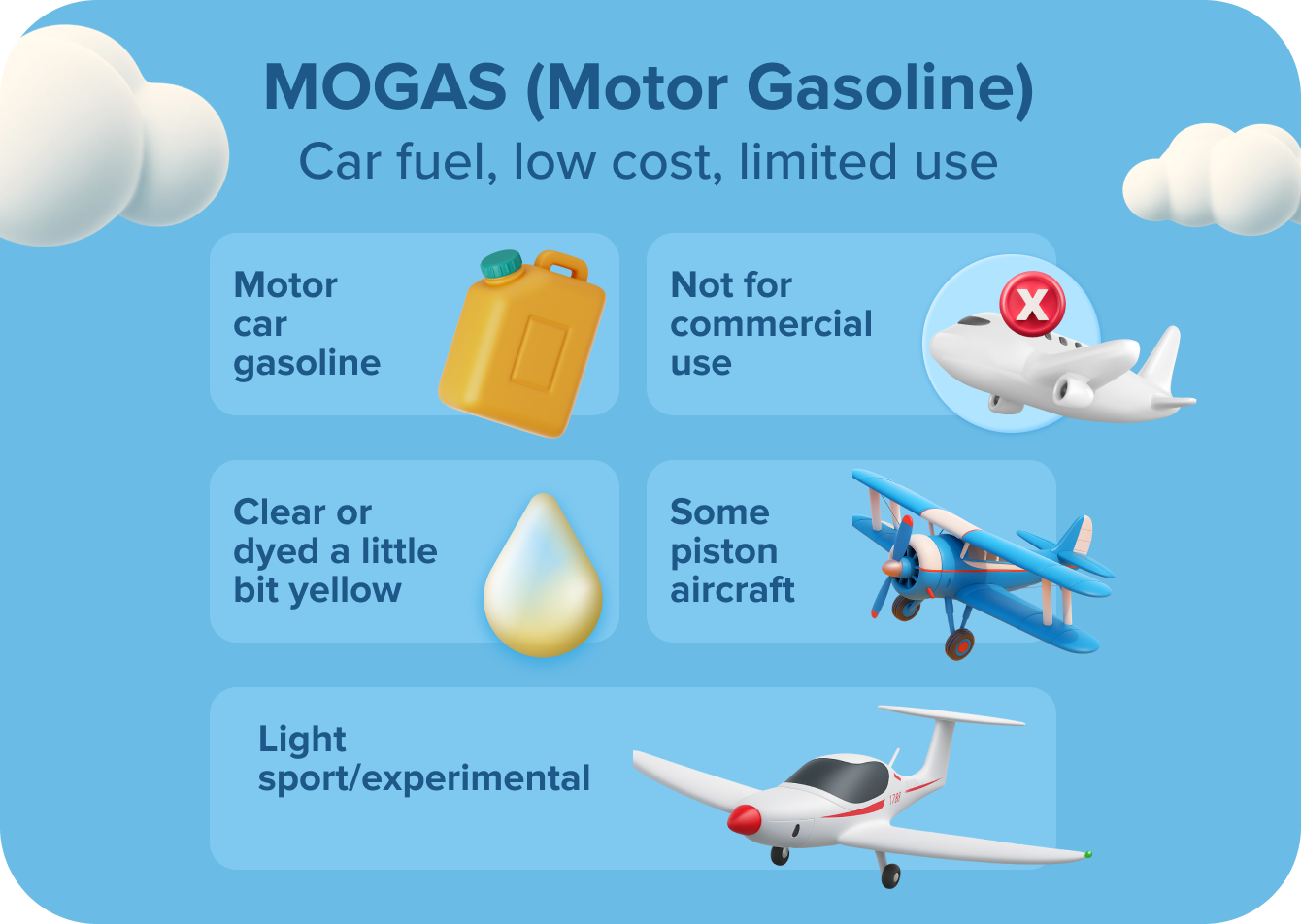
Used by: Light sport aircraft, some experimental aircraft, and certain STC-approved certified planes
MOGAS is essentially unleaded auto fuel (the same stuff you put in your car) used in aviation under very specific conditions. It’s cheaper and more widely available, but comes with caveats:
Not suitable for high-altitude or high-performance operations
May have ethanol content, which isn’t ideal for aircraft fuel systems
Jet B or Aftak JP4
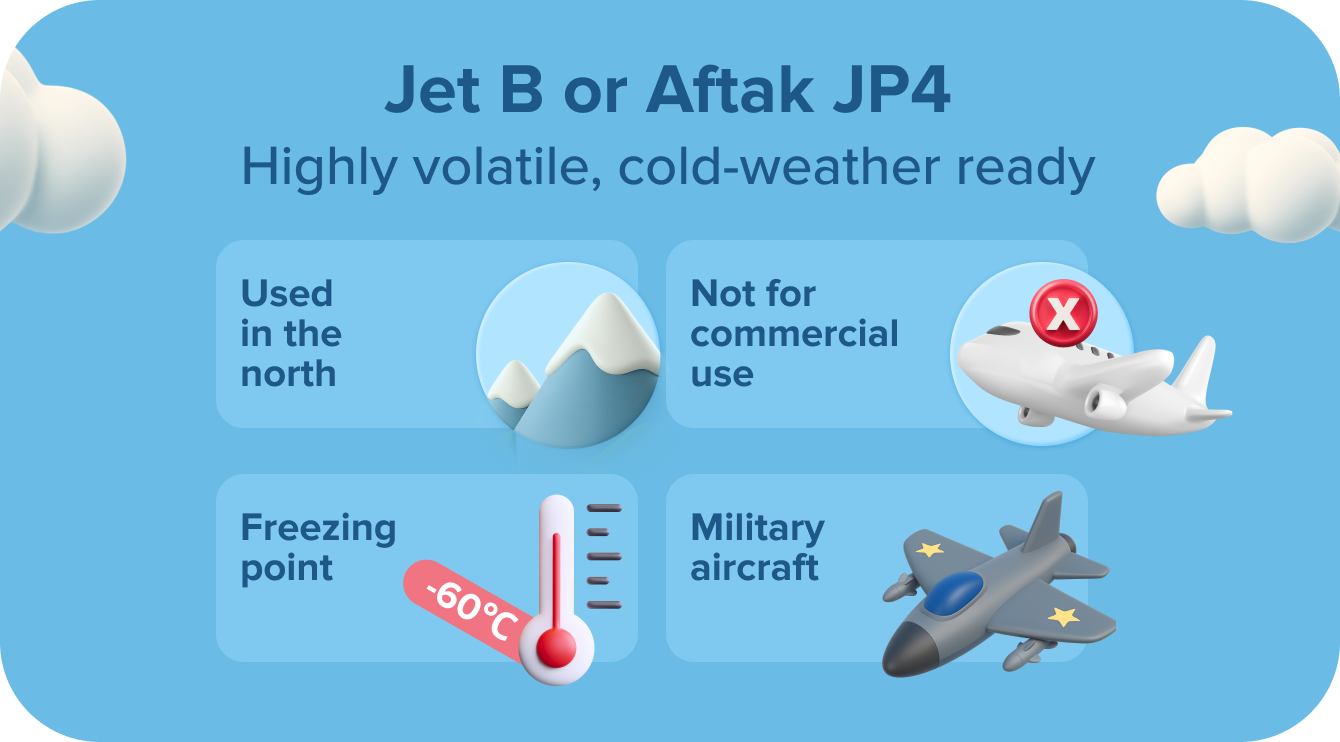
Used by: Military aircraft, Arctic region operations, remote bush flying
Jet B is a specialised aviation fuel designed for extremely cold climates. Its composition is a blend of roughly 30% kerosene and 70% gasoline, giving it a very low freezing point of approximately -60 °C. This makes it a practical choice for regions with consistently frigid temperatures, such as Alaska and parts of Canada.
However, Jet B's high volatility and flammability make it trickier to handle and store compared to other fuels. For this reason, it is used sparingly and primarily in sub-zero environments, where its low freezing point is essential for reliability. The military version, known as JP-4, is essentially Jet B with added corrosion inhibitor and anti-icing agents.
Military Fuels
The military needs fuels that can handle extreme conditions — on aircraft carriers, in desert heat, or in freezing altitudes. These advanced fuels are adapted versions of civilian jet fuels with additives for: anti-icing, corrosion inhibition, stability, and storage. Military fuels are robust and adaptable, just like the missions they support.
Examples include: JP-5 — high flash point, perfect for aircraft carriers. JP-8 — Similar to Jet A-1 but with military-specific additives.
Sustainable Aviation Fuel (SAF)
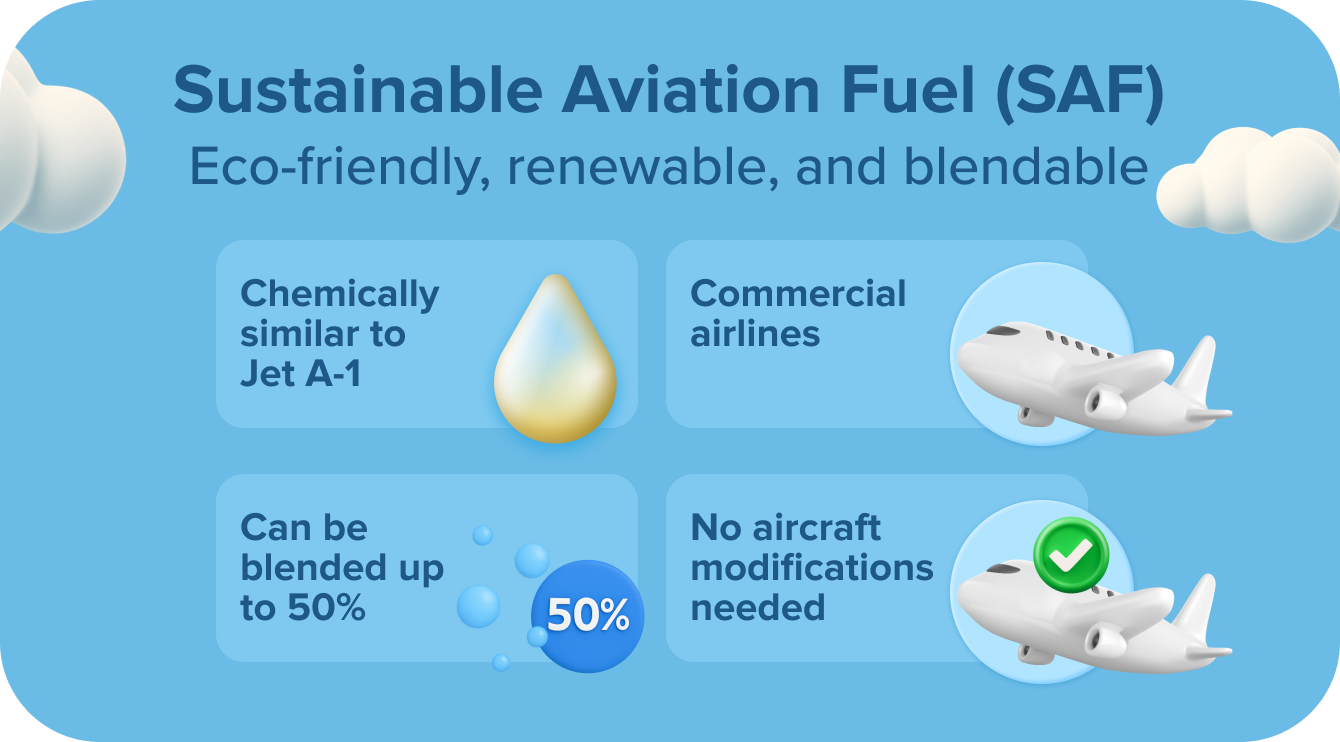
SAF is the green revolution in aviation fuel, increasingly adopted by commercial airlines around the globe.
Made from renewable feedstocks like used cooking oil, municipal waste, or algae, SAF is chemically similar to Jet A-1 and can be blended up to 50% with traditional jet fuel. No aircraft modifications required.
Airlines like Lufthansa, United, and KLM are already flying with SAF blends on select routes. The goal? Reduce aviation's carbon footprint without sacrificing performance or safety.
Understand the critical role of human factors in aviation safety and avoid common pitfalls by reading our blog post, The Dirty Dozen: 12 Critical Human Factors.
Aviation Fuel Cheat Sheet
Fuel Type | Used By | Key Traits |
Jet A / A-1 (AFTUR) | Airliners, jets | Kerosene-based, global standard |
Avgas 100LL / 100 | Piston-engine GA aircraft | High-octane gasoline with lead |
MOGAS | Light sport/experimental | Car fuel, low cost, limited use |
Jet B | Military, cold-climate ops | Highly volatile, cold-weather ready |
JP-Series (JP-5, JP-8) | Military aircraft | Speciality additives, extreme performance |
SAF | Commercial airlines | Eco-friendly, renewable, blendable |
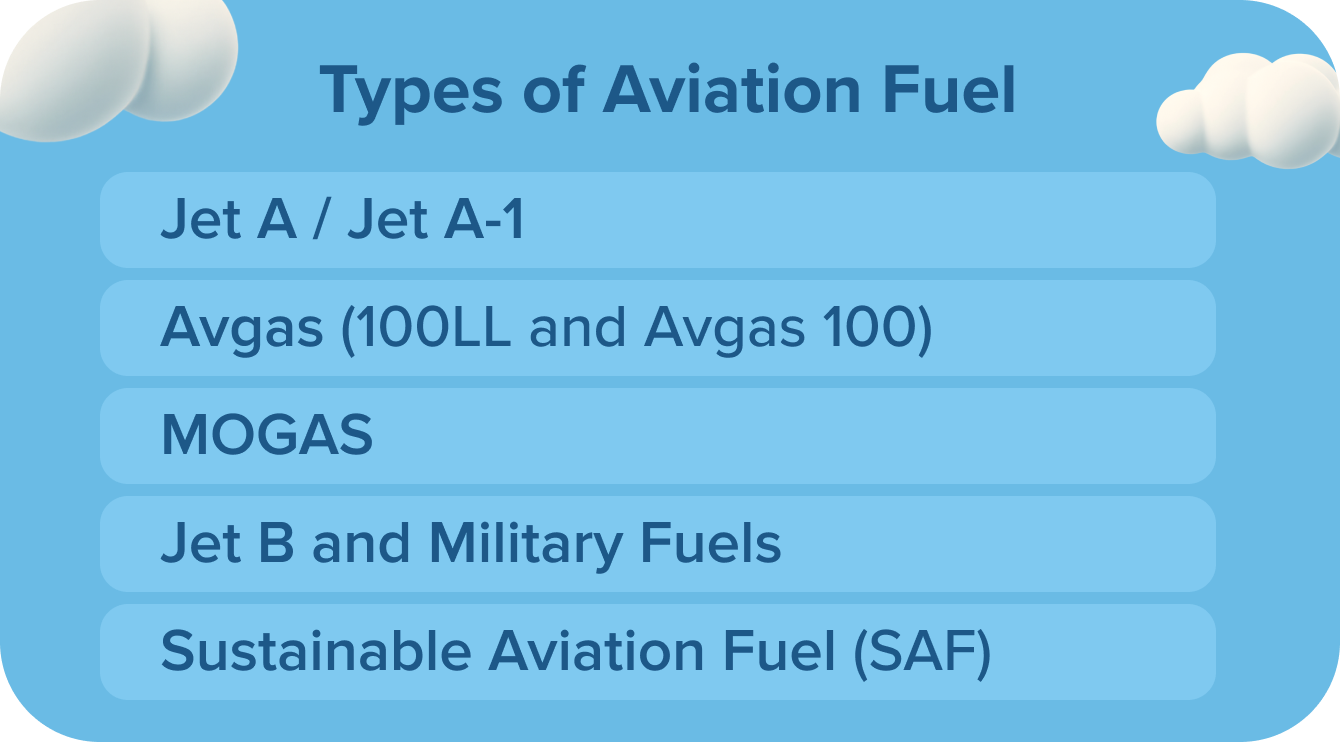
Finding it hard to learn how to fly? Training Challenges: 12 Reasons Why Student Pilots Quit offers insights and solutions to help you persevere.
Basic Fuel Planning for Pilots
Fuel mismanagement is a leading factor in aviation incidents, so every good pilot needs to treat this part of preflight prep with serious attention. Good planning ensures you always have enough fuel to handle expected operations and the unexpected — like delays, diversions, or holding patterns.
To make it easier, there’s a handy mnemonic pilots use: TTCAAFE. Each letter stands for a different type of fuel you need to consider. While the numbers may vary depending on the aircraft type, route, and weather conditions, the structure stays the same. Let’s break down the 7 key fuel components.
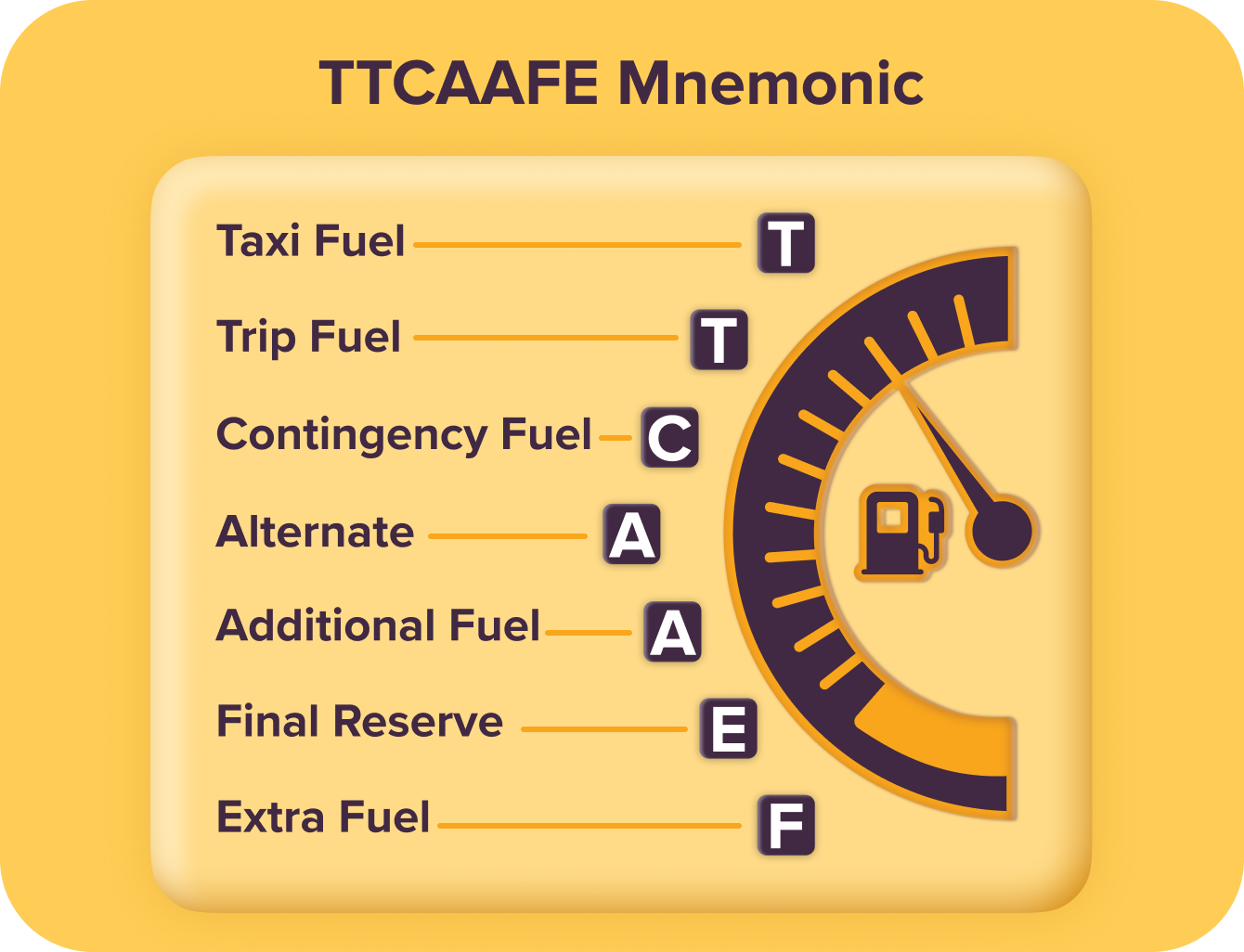
TTCAAFE
T – Taxi Fuel This covers fuel consumed during engine start, APU usage, taxi to the runway, and any anticipated holding before take-off. It’s typically a fixed amount (e.g. 200 kg), but it can vary depending on airport layout and expected delays.
T – Trip Fuel This is your core fuel load – the amount required to fly from wheels-up to touchdown. It includes the climb, cruise, and descent phases. Trip fuel is calculated using performance data, weather conditions, route structure, and expected aircraft weight.
C – Contingency Fuel This is your buffer for the unforeseen. It’s usually 5% of the trip fuel or 5 minutes of holding at 1,500 feet above the destination airport — whichever is higher. It covers deviations from planned routing, weather, or ATC instructions.
A – Alternate Fuel If a diversion is needed, this is the fuel required to fly from the missed approach point at your destination to your designated alternate airport, including climb, cruise, descent, and landing there.
A – Additional Fuel This applies when there’s no alternate listed (for example, if you’re landing at an isolated airport). Additional fuel typically allows 15 minutes of flight at 1,500 feet above the aerodrome, accounting for weather or runway availability issues.
Important: You’ll have either Alternate or Additional fuel — not both.
F – Final Reserve Fuel Your last line of defence. This is the minimum required if everything else goes wrong:
30 minutes at 1,500 feet for turbine aircraft
45 minutes for piston aircraft It’s not to be touched in normal operations — it’s for emergencies only.
E – Extra Fuel Optional, but smart. This is any additional fuel the commander decides to carry beyond the minimums — based on weather, expected delays, holding patterns, or operational experience.
Mastering AGK starts here! This blog breaks down aircraft parts from nose to tail, laying the foundation for your aircraft's general knowledge.
Fuel Dumping: What, When, and Where
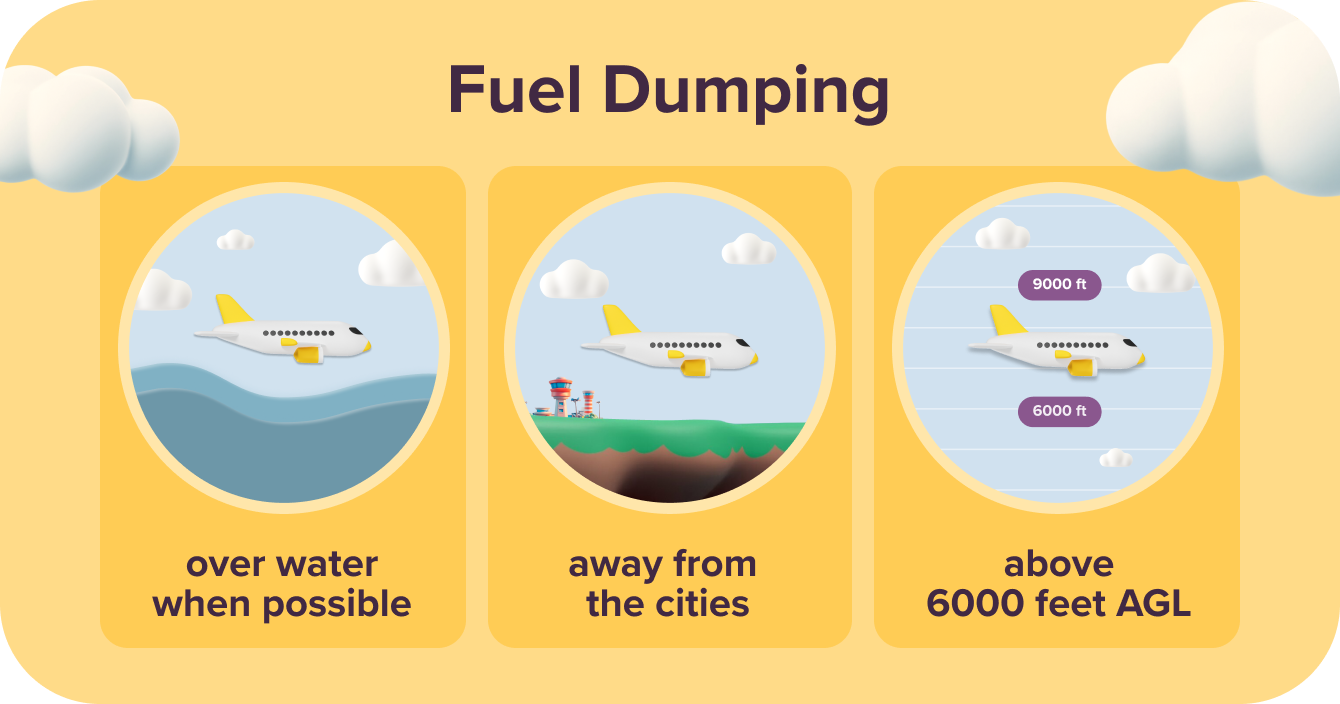
Fuel dumping, also called fuel jettisoning, is when an aircraft intentionally releases fuel in-flight. It’s not something pilots do for fun. It’s a safety manoeuvre, used only when absolutely necessary, usually in emergency or time-critical situations.
Most often, it happens when a plane needs to return shortly after take-off, or divert quickly after departure, but is too heavy to land safely. Long-haul jets typically take off at weights far above their maximum landing weight, so reducing mass becomes a priority before making a safe landing.
When Can It Be Done?
According to ICAO Doc 4444, fuel dumping is permitted only in emergency or urgent situations. Examples include:
A medical emergency that requires an immediate return or diversion
A technical fault that makes continuing unsafe
A sudden decompression or engine issue
But fuel can’t just be dumped anywhere. There are rules and procedures for where and how it happens.
Where Does it Happen?
Dumping usually takes place:
Above 6,000 feet AGL
Away from populated areas
Over water when possible
ATC (Air Traffic Control) coordinates with the crew to choose the safest location — typically a designated fuel dumping zone, such as offshore airspace or rural zones. The 6000-foot rule ensures the fuel atomises and evaporates before it even reaches the ground. That’s why you almost never hear of any environmental damage or risk to people below.
We’ve put together a quick collection of 15 Practical Questions and Answers that every student pilot should know cold. Test your knowledge and see how many of them you got right.
Can Jets Dump Fuel Over Cities?
Technically, yes—but it’s extremely rare and only if there’s no safer alternative. Even then, fuel dumped at altitude disperses quickly into mist-like particles.
So no, it’s not raining kerosene on your head. The environmental impact is minimal, and health risks are nearly zero — especially compared to the risk of a damaged or overweight aircraft trying to land.
Not All Aircraft Can Dump Fuel. Here’s a fact: not every plane has a fuel jettison system. Most narrowbodies — like the Airbus A320 or Boeing 737— can’t dump fuel at all. If they take-off heavy and need to return, the only option is an overweight landing.
Is that dangerous? It’s not ideal—but it’s manageable. Aircraft are designed to handle overweight landings when necessary. It may require a thorough inspection afterward, but safety comes first.
According to EASA CS-25, an aircraft isn’t required to meet max landing mass in all scenarios — it must be able to sustain climb gradients and perform safely during a go-around or engine-out situation.
5 Aviation Fuel Facts
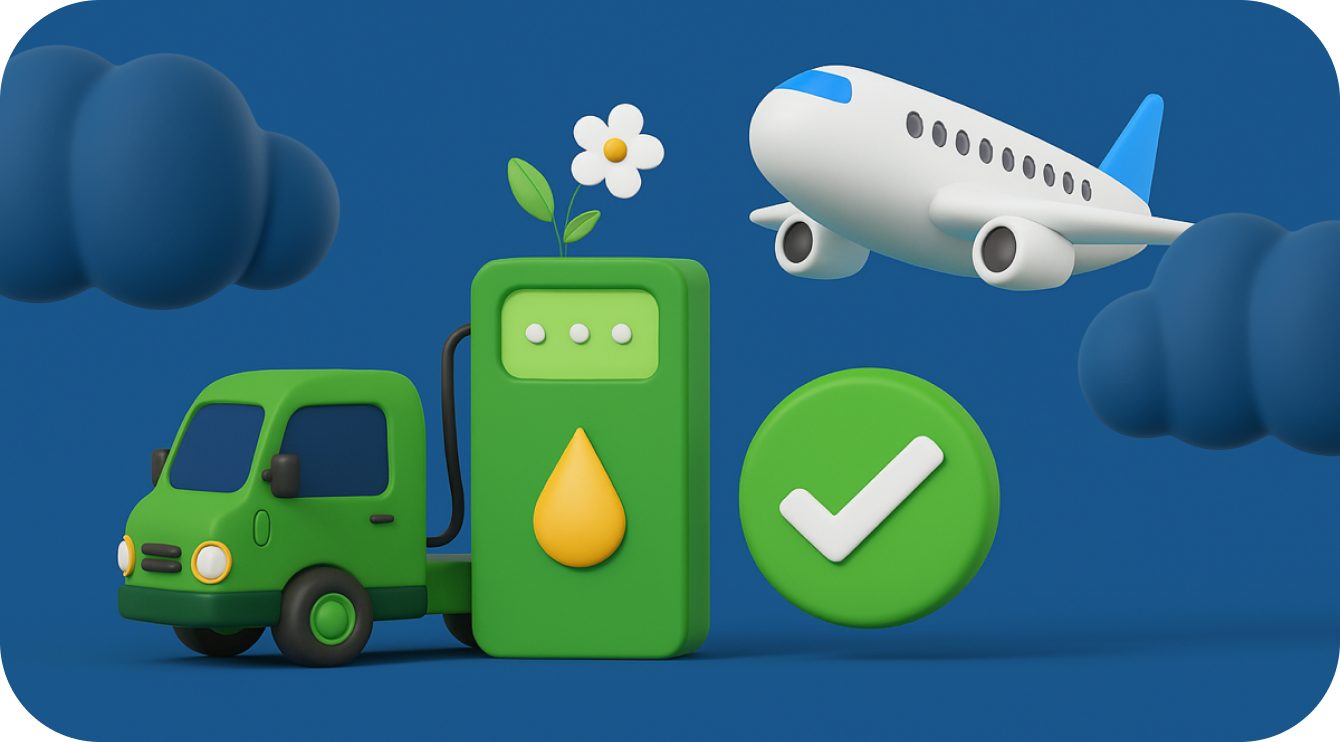
Before we end this guide to aviation fuel, let's look at a few quick facts that show one thing: aviation fuel, in every aspect of its production and use, is a critical, high-stakes resource that powers our industry.
1. Aviation Fuel Is Held to Seriously High Standards. Fuel isn’t just pumped into aircraft without checks. Aviation fuel must meet strict international quality standards, regardless of where it’s produced. That means a plane refuelled in Tokyo, Nairobi, or Madrid can trust the same performance and safety level. These standards ensure engine reliability, safety, and efficiency, no matter where in the world you're flying.
2. Jet Fuel ≠ Car Fuel. Here’s the deal: aviation fuel is not your average unleaded.
Jet fuel (like Jet A and Jet A-1) is primarily made from kerosene, a light hydrocarbon that performs well in high altitudes and cold temps.
Avgas (aviation gasoline), often used in smaller piston-engine aircraft, can be leaded or unleaded, and is designed for high-performance spark ignition.
Different fuels, different engines, but both are precision-formulated for aviation use.
3. Aviation Fuel Isn’t Cheap. Aviation fuel is a premium product — and its price reflects that. The refining, testing, and global logistics all add up. While it’s significantly more expensive than car fuel, it offers superior energy density, safety, and efficiency.
4. Avgas = Highly Flammable and Highly Regulated. Yes, Avgas is highly flammable, but so are most fuels. What sets aviation fuel apart is how it's handled and regulated. Every aircraft must have fire suppression systems, and anyone who handles fuel—ground crew, maintenance teams, even some pilots—needs special training.
5. Aviation Fuel Has Come a Long Way. Once upon a time, airplanes ran on pretty basic gasoline. But today’s jets burn highly engineered fuels designed for efficiency, safety, and performance at 35,000 feet. And the evolution isn’t stopping there. Biofuels and synthetic alternatives (like SAF) are already in use, helping the industry take meaningful steps toward greener, more sustainable skies.
